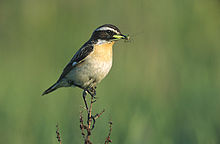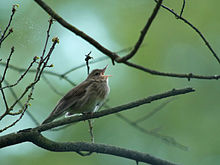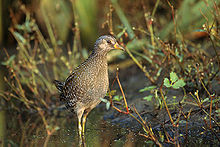Pfrunger and Burgweiler Ried
|
Bird sanctuary (SPA)
"Pfrunger and Burgweiler Ried" |
||
| location | Guggenhausen , Königseggwald , Riedhausen and Wilhelmsdorf in the Ravensburg district and Ostrach in the Sigmaringen district , Baden-Württemberg , Germany | |
| WDPA ID | 555537937 | |
| Natura 2000 ID | DE-8022-401 | |
| Bird sanctuary | 28.258 km² | |
| Geographical location | 47 ° 54 ' N , 9 ° 24' E | |
|
|
||
| Setup date | November 20, 2007 | |
| administration | Regional Council Tübingen | |
The area Pfrunger and Burgweiler Ried is a 2007 equipped with Regulation of 5 February 2010 by the Ministry of Food and Rural Areas specified European bird sanctuary (reserve identifier DE-8022-401) in the Württemberg Baden- counties Ravensburg and Sigmaringen in Germany .
location
The 2,825.8 hectare (ha) bird sanctuary in Pfrunger and Burgweiler Ried is located between Ostrach in the north and Wilhelmsdorf in the south, at an average altitude of 610 m above sea level. NN , and is distributed over five municipalities in the two counties
-
Ravensburg (1,392.4 ha)
- Municipalities of Guggenhausen (81.93 ha), Königseggwald (56.64 ha), Riedhausen (315.16 ha) and Wilhelmsdorf (938.69 ha)
-
Sigmaringen (1,433.4 ha)
- Ostrach community (1,433.4 ha)
It is almost congruent with the Pfrunger-Burgweiler Ried , which is the second largest contiguous moorland in southwest Germany after the Federsee with 2,600 hectares . The area is surrounded by tertiary molasse mountains, which reach their highest peaks in the Rinkenburg ( 718 m above sea level ) and the Höchst ( 837.8 m above sea level ).
Management plan
From April 2016 to summer 2018, a management plan is to be drawn up for the bird sanctuary and a full technical review and, if necessary, an adjustment of the external borders is to be carried out. For this purpose, the relevant habitat types and species are first recorded and then appropriate measures are formulated.
description
The area is described Pfrunger and Burgweiler Ried in glacial embossed area between the inner and outer Würmendmoräne as "extensive bog complex of high , intermediate and fens with large forests and grasslands, waters by peat cutting in all siltation levels, fallow wooded lateral moraines, orchard of local edges and fields ”.
Habitat classes
| Deciduous forest | 141 ha | |||
| Mixed forest | 226 ha | |||
| Coniferous forest | 113 ha | |||
| Moist and mesophilic grassland | 28 ha | |||
| Inland waters, flowing and standing | 198 ha | |||
| Bogs, swamps, growth on banks | 565 ha | |||
| drained grassland | 1,357 ha | |||
| other farmland | 198 ha | |||
meaning
The reserve is the most important breeding area for teal and common swirls in Baden-Württemberg as well as one of the most important breeding areas of spotted moorhen and white stork in Baden-Württemberg .
Protection purpose
The area-related conservation objectives are described differently depending on the species :
Tree falcon ( Falco subbuteo )
Preservation of light forests with bordering open landscapes, of old trees and islands of old wood, of overhangs, of field trees or groups of trees in fields or along waterways, of extensively used grassland, of waterways with structurally rich bank areas and silting areas, of nesting opportunities such as crow's nests, of the food supply, in particular with small birds and large insects as well as undisturbed or at least undisturbed breeding sites during the breeding season from April 15 to September 15.
Common Common Snipe ( Gallinago gallinago )
Preservation of the wet meadow complexes, especially with litter meadows or extensively used wet meadows, the near-natural brook valleys and moors, the silting areas of stagnant water with light reeds or sedge beds, the habitats without sources of danger such as overhead lines, maintenance of flood hollows, leading ditches that are temporarily flooded, and wet arable fields , of grass, reed and perennial borders as well as maintenance of undisturbed or at least undisturbed breeding sites during the breeding season between February 15 and August 15.
Whinchat ( Saxicola rubetra )
Preservation of largely late-mowed extensively managed grassland complexes, large sedge areas, moors and heaths, fringing strips such as road and field borders as well as edge strips, old grass strips, fallow and wood-free embankments, isolated bushes, tall perennials, piles of stones and others as hunting, sitting and Singwarten suitable structures, secondary habitats such as abandoned mining sites with the aforementioned habitats, the food supply as well as undisturbed or at least undisturbed breeding sites during the breeding season from May 1 to August 31.
Kingfisher ( Alcedo atthis )
Preservation of near-natural waters, of steep walls and demolition edges made of excavable substrate in the vicinity of the water, of fallen trees suitable for the breeding tube system in the vicinity of the water, of structures that can be used as a seat for hunting such as strong riparian wood with branches hanging over the water, preservation of a Water quality that ensures good visibility for prey, a water dynamic that enables the formation of new bank breaks suitable for nesting, preservation of secondary habitats such as abandoned mining sites with bodies of water and steep banks, the food supply with small fish species and juvenile fish as well as the maintenance of undisturbed or at least undisturbed breeding sites during the breeding season from February 15th to September 15th.
Common tern ( Sterna hirundo )
Preservation of near-natural waters, existing nesting opportunities, the food supply with small fish species and juvenile fish, a water quality that ensures good visibility conditions for prey, as well as undisturbed or at least undisturbed breeding sites during the breeding season from April 1st to September 30th.
Gray woodpecker ( Picus canus )
Preservation of richly structured light deciduous and mixed deciduous forests with open areas for feeding, of alluvial forests, of extensively cultivated orchards, preservation of poor grasslands, poor hay meadows or cattle pastures, preservation of edge strips, rain areas, embankments and lined, stepped forest edges, of old wood islands and old wood islands , especially of standing dead wood, preservation of trees with large caves and the food supply.
Common teal ( anas crecca )
Preservation of the eutrophic vegetation-rich peat lakes, small bodies of water and wet meadow ditches carrying water, the slowly flowing bodies of water with shallow water zones, the silted areas with reeds, sedge beds, watery woody plants, silt areas and shallow water zones as well as preservation of undisturbed or at least undisturbed breeding and moulting sites during the breeding season (March 15 to August 31) and the moult (July 1 to September 30).
Red- backed shrike ( Lanius collurio )
Preservation of extensively managed orchards, grassland and heathland areas, of low and medium hedges from native species, in particular thorn or prickly wooded trees, preservation of litter meadows and open bog edges, preservation of individual trees and bushes in the open landscape, of field lines, grass paths, Ruderal and perennial corridors and fallow land, field and meadow margins, secondary habitats such as abandoned mining sites with the aforementioned habitats and maintenance of the food supply, especially with larger insects.
Little Owl ( Aegolius funereus )
Preservation of structurally rich and large-area coniferous or mixed forests, in particular mixed coniferous forests rich in beech, of mosaics from light old wood stocks and clearings as well as pole wood and thickening areas, of standing dead wood with large trunk diameters, preservation of trees with large caves as well as preservation of undisturbed or at least undisturbed breeding sites during the breeding season March 1st to August 1st.
Marsh harrier ( Circus aeruginosus )
Preservation of silting zones, reed beds, large sedge areas, wet meadow complexes with litter meadows or extensively used wet meadows, habitats without sources of danger such as non-bird-safe overhead lines and wind turbines, preservation of grass and perennial borders, secondary habitats such as abandoned peat cuttings with the aforementioned habitats as well as maintenance of at least non-disruptive sites during the breeding season or at least non-disruptive from March 15th to September 15th.
Red kite ( Milvus milvus )
Preservation of diversely structured cultural landscapes with sparse forests, of field trees, large individual trees and rows of trees in the open landscape, of grassland, of old wood islands and old, large-crowned trees with free approach, preservation of trees with clumps, habitats without sources of danger such as non-bird-safe overhead lines and Wind turbines and the maintenance of undisturbed or at least low-disturbance breeding sites during the breeding season from March 1st to August 31st.
Schlagschwirl ( Locustella fluviatilis )
Preservation of the fens, flowing and still waters accompanying dense bank vegetation and of wetlands with succession and foresting stages, of light floodplain forests and secondary habitats such as abandoned peat cuttings with the aforementioned habitats.
Black kite ( Milvus migrans )
Preservation of diversely structured cultural landscapes, of sparse forests, in particular alluvial forests, of field trees, large individual trees and rows of trees in the open landscape, grassland, islands of old wood and old, large-crowned trees with free approach, especially near the forest edge, preservation of natural flowing and still waters, conservation of trees with clumps, of habitats without sources of danger such as non-bird-safe overhead lines and wind turbines as well as maintenance of undisturbed or at least undisturbed breeding sites during the breeding season from March 1st to August 15th.
Black Woodpecker ( Dryocopus martius )
Preservation of extensive forests, old trees and islands of old wood, dead wood, preservation of trees with large caves as well as the food supply, especially with ants.
Spotted Moorhen ( Porzana porzana )
Preservation of silting zones with low-flooded varied herbaceous vegetation such as in transition zones between reed beds and large sedge beds, in the bank area of extensive reed stands and in flooded wet meadows, maintenance of a shallow overflow of habitats during the entire breeding season (March 15 to August 15), preservation of habitats without sources of danger such as overhead lines, preservation of secondary habitats such as waterlogged peat cuttings and drainage ditches with strips of reeds, sedge bulbs and a loose herbaceous layer as well as undisturbed or at least undisturbed breeding sites.
Water rail ( Rallus aquaticus )
Preservation of standing water with shallow water zones, flowing water sections and ditches with vegetation rich in cover, reeds and moors with at least small open water areas, silted areas with high cover with shallowly flooded reed beds, large sedge beds and bank bushes, habitats without sources of danger such as overhead lines, preservation of secondary habitats such as abandoned peat areas with the aforementioned habitats and maintenance of undisturbed or at least low-disturbance breeding sites during the breeding season from March 15th to September 15th.
White stork ( Ciconia ciconia )
Preservation of extensive, extensively used grassland with wet meadows and cattle pastures, temporally differentiated uses in grassland, of grass, reed and perennial borders, especially in connection with meadow ditches, of high groundwater levels, maintenance of fens, ponds, ponds, water ditches, temporarily flooded Sinks, habitats without sources of danger, such as non-bird-safe overhead lines and unsecured chimneys, as well as maintaining the food supply, especially with small mammals, amphibians, reptiles, large insects and worms.
Honey buzzard ( Pernis apivorus )
Preservation of diversely structured cultural landscapes, light deciduous and mixed and pine forests, field trees, extensively used grassland, old wood islands and old, large-crowned trees with free approach, preservation of the poor grasslands, trees with clumps, preservation of the food supply, especially with wasps and bumblebees that form states as well as the maintenance of undisturbed or at least low-disturbance breeding sites during the breeding season from May 1st to August 31st.
Little Grebe ( Tachybaptus ruficollis )
Preservation of at least partially covered still waters, wet meadow ditches, slow-flowing brooks and meadow ditches, siltation zones with reed beds such as reeds, bulrushes, swaths of water or reed grass, maintenance of a water quality that guarantees good visibility for prey, preservation of secondary habitats such as abandoned peat cuttings Habitat and maintenance of undisturbed or at least undisturbed breeding sites during the breeding season (February 15 to September 15).
Connection with other protected areas
Protected areas connected with the Pfrunger and Burgweiler Ried bird sanctuary are the nature reserves Laubbachmühle (NSG No. 4.090), Mühlebach (NSG No. 4.258), Pfrunger-Burgweiler Ried (NSG No. 4.028), and overgrown lake (NSG No. 4.068 ), the landscape protection areas Altshausen-Laubbach-Fleischwangen (LSG number 4.37.030) and Pfrunger Ried - Rinkenburg (LSG number 4.36.010) as well as the FFH area Pfrunger Ried and Lakes near Illmensee (No. 8122-342).
See also
Web links
- Standard data sheet for the bird sanctuary "Pfrunger and Burgweiler Ried"
- Ordinance, data evaluation sheet and map in the profile of the SPA area Pfrunger and Burgweiler Ried in the LUBW protected area directory
Individual evidence
- ↑ Ordinance of the Ministry of Food and Rural Areas establishing European bird protection areas (VSG-VO). Retrieved August 22, 2018 .
- ↑ Bulletin - Official Bakanntmachungen local government Ostrach; No. 15, 40th year; April 14, 2016
- ↑ Annex 1 of the ordinance of the Ministry of Food and Rural Areas establishing European bird protection areas (VSG-VO) of February 5, 2010. Accessed on August 22, 2018 .






